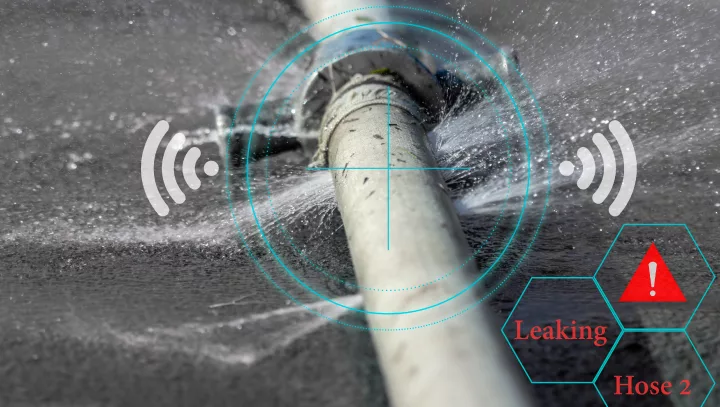The Relevance of Routine Water Leak Detection for Long-Term Home Security
The Relevance of Routine Water Leak Detection for Long-Term Home Security
Blog Article
Innovative Solutions for Very Early Discovery of Water Leaks in Buildings and Framework
As the honesty of structures and infrastructure is extremely important, the obstacle of very early detection of water leakages has actually stimulated ingenious options that guarantee to transform the method we guard versus prospective damages. From advanced leak discovery technologies to the release of IoT sensing units for real-time surveillance, the landscape of leak prevention is advancing rapidly. Artificial intelligence algorithms offer a glance into the future of leakage prediction, while thermal imaging provides a non-intrusive approach for pinpointing hidden leakages. Automated water flow evaluation systems are improving just how leakages are recognized and dealt with, leading the way for a proactive strategy to water leak detection. Each of these solutions holds the vital to guaranteeing the dependability and durability of our constructed environment, triggering a shift towards a much more lasting and reliable future.
Advanced Leak Discovery Technologies
Advanced leak detection technologies, furnished with advanced sensors and algorithms, play a crucial role in quickly recognizing and determining water leakages in various settings. These technologies employ a combination of acoustic, thermal, and electromagnetic noticing approaches to spot leaks properly. Acoustic sensing units discover the noise of running away water, enabling specific localization of the leakage resource. Thermal imaging identifies temperature level modifications triggered by water leakage, offering one more reliable technique for leakage identification. Electromagnetic sensors can recognize adjustments in magnetic fields created by water, using yet an additional layer of leakage discovery ability.

IoT Sensors for Real-Time Tracking
In the world of modern water leak detection, the assimilation of IoT sensing units for real-time monitoring represents a critical development in improving aggressive leakage detection capacities. These sensors offer constant tracking of water supply, supplying real-time data on water flow rates, pressure variants, and temperature level changes. By leveraging IoT innovation, these sensors can identify also the tiniest anomalies in water use patterns, allowing early identification of prospective leaks prior to they escalate right into significant issues.
IoT sensing units transmit information to a central platform, where advanced algorithms assess the info and create notifies or notices when irregularities are spotted. This real-time tracking capacity permits residential or commercial property owners or center supervisors to without delay address leaks, decreasing water damages, Visit This Link decreasing repair costs, and preserving water resources.
Moreover, IoT sensors can be incorporated with structure management systems, permitting computerized feedbacks to spotted leakages, such as shutting down water shutoffs or triggering pumps to alleviate the effect of leaks. Generally, the execution of IoT sensing units for real-time surveillance considerably enhances the effectiveness and efficiency of water leakage discovery in structures and infrastructure.
Artificial Intelligence Algorithms for Leak Prediction

One trick benefit of making use of artificial intelligence for leak forecast is its capability to continuously discover and enhance its accuracy with time. As more data is gathered and fed into the formula, it can improve its forecasts and adapt to changing problems, ultimately enhancing the reliability of leak discovery systems.
In addition, equipment learning algorithms can aid in determining subtle signs of leakages that may go undetected by conventional tracking techniques. water leak detection. By evaluating complicated data embed in real-time, these formulas can provide early cautions and informs, enabling for prompt treatment and preventative upkeep to reduce prospective water damages and linked expenses
Using Thermal Imaging for Leakage Detection
Thermal imaging innovation offers an appealing strategy for finding water leakages in numerous systems and frameworks. By utilizing infrared radiation and temperature variations, thermal imaging cameras can recognize concealed leaks that are not conveniently visible to the naked eye.
One of the crucial benefits of thermal imaging for leakage discovery is its non-intrusive nature. Unlike standard techniques that might require getting into wall surfaces or floorings to situate leaks, thermal imaging enables non-destructive testing. This not only saves time and minimizes expenses find here yet likewise minimizes disturbance to the structure or framework being evaluated. In addition, thermal imaging can promptly check large areas, providing an extensive summary of potential leak sources in a timely fashion. Overall, using thermal imaging modern technology boosts the efficiency and precision of water leak detection, making it an important device for maintaining the stability of buildings and frameworks.
Automated Water Circulation Evaluation Equipments
Just how can automatic water flow evaluation systems revolutionize the discovery and monitoring of leakages in different systems and facilities? Automated water flow analysis systems provide an aggressive technique to leakage detection by continually keeping an eye on water circulation rates and patterns. By establishing standard data, these systems can quickly identify discrepancies that may show a leak, allowing prompt treatment to stop extensive damages.
These systems use advanced algorithms to evaluate real-time information and offer prompt informs when abnormalities are found, permitting quick activity to be taken. Furthermore, automatic water circulation evaluation systems can be integrated with building monitoring systems or IoT systems, improving general efficiency and enabling remote tracking abilities.
In addition, the information collected by these systems can be utilized for predictive maintenance functions, helping to recognize potential powerlessness in the infrastructure prior to leaks occur. In general, the application of computerized water flow analysis systems can dramatically boost leakage discovery and management techniques, ultimately leading to set you back financial savings, minimized water waste, and enhanced sustainability in buildings and framework.

Verdict
Finally, the combination of sophisticated leakage detection modern technologies, IoT sensors, artificial intelligence algorithms, thermal imaging, and automatic water circulation analysis systems supplies innovative solutions for early discovery of water leaks in buildings and infrastructure. These technologies allow real-time tracking, forecast of leaks, and effective discovery techniques to avoid water damages and wastage. Applying these remedies can help in keeping the integrity and sustainability of water systems in various settings.
Report this page